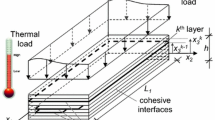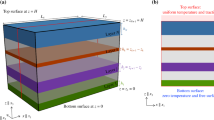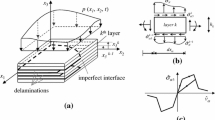Abstract
A matrix technique is formulated to efficiently solve stationary two-dimensional thermo-elasticity problems in simply supported multilayered beams and plates with an arbitrary number of layers which may be in imperfect mechanical and thermal contact. The method uses local transfer matrices and continuity conditions at the layer interfaces to establish explicit relationships between the unknown integration constants in the solution of a generic layer and those of the first layer. Explicit expressions are then derived for temperature, displacements and stresses through the imposition of the boundary conditions at the top and bottom surfaces of the plate. The dimensionless expressions allow to easily generate exact solutions, also for plates with many layers and interfacial thermal and mechanical imperfections. The solutions can be used for parametric analyses, to investigate the influence of the inhomogeneous material structure and interfacial imperfections on local fields or to verify the accuracy of approximate theories and numerical models.



Similar content being viewed by others
References
Pagano NJ (1969) Exact solutions for composite laminates in cylindrical bending. J Compos Mater 3:398–411
Pagano NJ (1970) Exact solutions for rectangular bidirectional composites and sandwich plates. J Compos Mater 4:20–34
Srinivas S, Rao AK (1970) Bending, vibration and buckling of simply supported thick orthotropic rectangular plates and laminates. Int J Solids Struct 6:1463–1481
Bhaskar K, Varadan TK, Ali JSM (1996) Thermoelastic solutions for orthotropic and anisotropic composite laminates. Compos Part B-Eng 27:415–420
Pagano NJ, Wang ASD (1971) Further study of composite laminates under cylindrical bending. J Compos Mater 5:521–528
Pagano NJ, Hatfield SJ (1972) Elastic behavior of multilayered bidirectional composites. AIAA J 10:931–933
Savoia M, Reddy JN (1995) Three-dimensional thermal analysis of laminated composite plates. Int J Solids Struct 32:593–608
Tungikar VB, Rao KM (1994) Three dimensional exact solution of thermal stresses in rectangular composite laminate. Compos Struct 27:419–430
Tauchert TR (1980) Thermoelastic analysis of laminated orthotropic slabs. J Therm Stresses 3:117–132
Williams TO, Addessio FL (1997) A general theory for laminated plates with delaminations. Int J Solids Struct 34:2003–2024
Vel SS, Batra RC (2002) Exact solution for Thermoelastic deformations of functionally graded thick rectangular plates. AIAA J 40:1421–1433
Massabò R, Campi F (2015) Assessment and correction of theories for multilayered plates with imperfect interfaces. Meccanica 50:1045–1071
Pelassa M, Massabò R (2015) Explicit solutions for multi-layered wide plates and beams with perfect and imperfect bonding and delaminations under thermo-mechanical loading. Meccanica 50:2497–2524
Thomson WT (1950) Transmission of elastic waves through a stratified solid medium. J Appl Phys 21:89–93
Kardomateas GA, Phan CN (2011) Three-dimensional elasticity solution for sandwich beams/wide plates with orthotropic phases: the negative discriminant case. J Sandw Struct Mater 13:641–661
Chen WQ, Cai JB, Ye GR (2003) Exact solutions of cross-ply laminates with bonding imperfections. AIAA J 41:2244–2250
Kim GW, Lee KY (2007) Influence of weak interfaces on buckling of orthotropic rectangular laminates. Compos Struct 81:427–431
Kapuria S, Dhanesh N (2015) Three-dimensional extended Kantorovich solution for accurate prediction of interlaminar stresses in composite laminated panels with interfacial imperfections. J Eng Mech 141:04014140
Boley BA, Weiner JH (1960) Theory of thermal stresses. John Wiley & Sons Inc, New York
Darban H, Massabò R (2017) 2D thermo-elastic solutions for laminates and sandwiches with interlayer delaminations and imperfect thermal contact. In: Lopresto V, Langella A, Abrate S (eds) Dynamic response and failure of composite materials and structures. Woodhead Publishing, UK (in press)
Chen TC, Jang HI (1995) Thermal stresses in a multilayered anisotropic medium with interface thermal resistance. J Appl Mech Trans ASME 62:810–811
Blandford GE, Tauchert TR (1985) Thermoelastic analysis of layered structures with imperfect layer contact. Comput Struct 21:1283–1291
Haskell NA (1953) The dispersion of surface waves on multilayered media. Bull Seism Soc Am 43:17–34
Lowe MJS (1995) Matrix techniques for modeling ultrasonic waves in multilayered media. IEEE Trans Ultrason Ferroelect Freq Control 42:525–542
Fan J, Ye J (1990) An exact solution for the statics and dynamics of laminated thick plates with orthotropic layers. Int J Solids Struct 26:655–662
Fan J, Ye J (1993) Exact solutions of buckling for simply supported thick laminates. Compos Struct 24:23–28
Qian H, Zhou D, Liu W, Fang H, Lu WD (2015) 3-D elasticity solutions of layered rectangular plates subjected to thermo-loads. J Therm Stresses 38:377–398
Qian H, Zhou D, Liu W, Fang H (2014) 3-D elasticity solutions of simply supported laminated rectangular plates in uniform temperature field. J Therm Stresses 37:661–677
Qian H, Zhou D, Liu W, Fang H, Lu WD (2015) Elasticity solutions of simply supported laminated cylindrical arches subjected to thermo-loads. Compos Struct 131:273–281
Buckingham E (1914) On physically similar systems; illustrations of the use of dimensional equations. Phys Rev 4:345–376
Acknowledgements
Support by the U.S. Office of Naval Research, contract no. N00014-14-1-0254, program manager Dr. Y. D. S. Rajapakse, is acknowledged. The second author also acknowledges financial support of the (MURST) Italian Department for University and Scientific and Technological Research in the framework of the research MIUR Prin15 project 2015LYYXA8, Multi-scale mechanical models for the design and optimization of micro-structured smart materials and metamaterials, coordinated by prof. A. Corigliano. The authors wish to thank prof. Serge Abrate who introduced them to the transfer matrix method and provided references.
Funding
This study was funded by the U.S. Office of Naval Research (contract number N00014-14-1-0254) and by the Italian MURST (contract number 2015LYYXA8).
Author information
Authors and Affiliations
Corresponding author
Ethics declarations
Conflict of interest
The authors declare that they have no conflict of interest.
Appendices
Appendix 1: Dimensionless forms
Dimensional quantities and groups which appear throughout the model are listed below along with their dimensionless counterparts. If the quantities which appear in the equations in the paper are interpreted as their dimensionless counterparts, the equations are dimensionless (see Table 2).
Appendix 2: Derivation of the unknown constants of the heat conduction problem
Equation (21) is expanded as:
where:
The terms \({}^{(k)}Z_{ir}\), for i, r = 1, 2 are:
the \({}^{(1)}D_{tj} \left( {x_{3}^{0} } \right)\) are given in Eq. (16) and the \({}^{(k)}N_{rt}\), for r, t = 1, 2, are defined by the recursive formula:
where:
For perfect thermal contact, the \(R^{k}\) terms in Eq. (45) vanish. The terms given in Eqs. (43)–(45) are the coefficients of the matrices \({}^{(k)}Z = {}^{(k)}D^{ - 1} (x_{3}^{k} )\left( {J^{k} } \right)^{ - 1}\), \({}^{(k)}N = \prod\nolimits_{i = k}^{1} {{}^{(i)}A}\) and \({}^{(i)}A = \left( {J^{i} } \right){}^{(i)}D(x_{3}^{i} ){}^{(i)}D^{ - 1} (x_{3}^{i - 1} )\). Application of the boundary conditions at the top and bottom surfaces of the plate and using Eq. (41) for \(k = n\), result in the following explicit expressions for the unknown constants of the first layer:
Appendix 3: Unknown constants of the particular solution of layer k
Appendix 4: Matrix \({}^{({\varvec{k}})}{\varvec{E}}\)
Positive discriminant:
Zero discriminant:
This case occurs when the layer is isotropic.
where \({}^{(k)}\nu\) and \({}^{(k)}E\) are Poisson ratio and Young’s modulus of the layer k and \(p = {{m\pi } \mathord{\left/ {\vphantom {{m\pi } L}} \right. \kern-0pt} L}\) with \(m \in {\mathbb{N}}\).
Negative discriminant:
This case occurs when the transverse stiffness of the layer is much higher than the in-plane stiffnesses.
with:
where \({}^{(k)}\Delta = {}^{(k)}(A_{1}^{2} - 4A_{0} A_{2} )\) and \({}^{(k)}A_{0}\), \({}^{(k)}A_{1}\) and \({}^{(k)}A_{2}\) are defined in Eq. (26).
Appendix 5: Derivation of displacements and stresses
An explicit relationship between \({}^{(k)}M(x_{3}^{k} )\) and \({}^{(1)}M(x_{3}^{0} )\) is obtained using Eqs. (34) and (35) and following the procedure presented in the main text for the heat conduction problem:
Expressions relating the four unknown constants, \({}^{(k)}a_{11}\), \({}^{(k)}a_{21}\), \({}^{(k)}a_{12}\) and \({}^{(k)}a_{22}\), to \({}^{(1)}M(x_{3}^{0} )\) are derived by substituting \({}^{(k)}M(x_{3}^{k} )\) on the left hand side of (52) with Eq. (32) and multiplying both sides by \({}^{(k)}E^{ - 1} (x_{3}^{k} )\):
for k = 2, …, n. Inserting the expressions of the unknown in (53) into (32) yields:
Equation (30) defines displacements and transverse stresses in the layer k in terms of \({}^{(k)}M(x_{3} )\), which is given in Eq. (54). The elements of the vector \({}^{(1)}M(x_{3}^{0} )\) in Eq. (54) are defined as follows. The third and fourth elements are obtained using Eq. (30) for \(x_{3} = x_{3}^{0}\) and k = 1 and the boundary conditions (10); the first and second elements are obtained using Eqs. (52) for k = n and the boundary conditions (10):
where \(\mu_{i}\) for i = 3, 4 are:
and \({}^{(k)}\varOmega_{ \, ig}\) and \({}^{(k)}S_{i}\) are defined by the recursive formulas:
where the elements of \({}^{(k)}Q(x_{3} )\) and \(B^{k}\) are given in Eqs. (33) and (36) and those of \({}^{(k)}E(x_{3} )\) in Appendix 4. For fully bonded layers Eq. (57) simplifies as:
Explicit expressions for displacements and stresses in the generic layer k are given in Eqs. (38) in the main text.
Rights and permissions
About this article
Cite this article
Darban, H., Massabò, R. Thermo-elastic solutions for multilayered wide plates and beams with interfacial imperfections through the transfer matrix method. Meccanica 53, 553–571 (2018). https://doi.org/10.1007/s11012-017-0657-6
Received:
Accepted:
Published:
Issue Date:
DOI: https://doi.org/10.1007/s11012-017-0657-6




